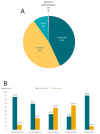Irrational Use of Medications among Adults with Insomnia: An Observational Study at a Sleep Clinic in Mexico
- PMID: 38668082
- PMCID: PMC11054186
- DOI: 10.3390/pharmacy12020056
Irrational Use of Medications among Adults with Insomnia: An Observational Study at a Sleep Clinic in Mexico
Abstract
Background: To determine the patterns of irrational use of medications among a sample of adult patients with insomnia.
Methods: We included 89 adult patients diagnosed with chronic insomnia who had consumed medications for this disorder during the 12 months prior to admission to a specialized Sleep Disorders Clinic (SDC) in Mexico City. With a 13-item survey, information was gathered on patterns of medication use and irrational use, considering therapeutic indications, dose, route of administration, and duration of treatment.
Results: The participants had taken hypnotics (65%), antidepressants (21%), anticonvulsants (8%), and antipsychotics (6%), and 92% had irrational use of their medication. Irrational use was greatest with benzodiazepines and antipsychotics. There were two main types of irrational use: (1) 47% of participants had consumed a drug unsuitable for their condition, although it was almost always prescribed by a doctor, and (2) 43% had consumed a drug for longer than the maximum time recommended.
Conclusion: It is worrisome to find that the irrational use of medications to treat insomnia, especially benzodiazepines and antipsychotics is widespread. Although most participants had acquired their medication by prescription, for many the drug was inappropriate to treat their condition. It should be mandatory that patients with insomnia receive specialized medical attention in primary clinical care.
Keywords: anticonvulsants; antidepressants; antipsychotics; hypnotics; insomnia; irrational use of drugs.
Conflict of interest statement
The authors declare no conflicts of interest.
Figures



Similar articles
-
Patterns of sleep-related medications prescribed to elderly outpatients with insomnia in Taiwan.Drugs Aging. 2005;22(11):957-65. doi: 10.2165/00002512-200522110-00005. Drugs Aging. 2005. PMID: 16323972
-
What is the role of sedating antidepressants, antipsychotics, and anticonvulsants in the management of insomnia?Curr Psychiatry Rep. 2012 Oct;14(5):494-502. doi: 10.1007/s11920-012-0302-y. Curr Psychiatry Rep. 2012. PMID: 22923053 Review.
-
Role of community pharmacists in the detection of potentially inappropriate benzodiazepines prescriptions for insomnia.Int J Clin Pharm. 2015 Dec;37(6):1004-8. doi: 10.1007/s11096-015-0166-4. Epub 2015 Jul 22. Int J Clin Pharm. 2015. PMID: 26198541
-
Review of Safety and Efficacy of Sleep Medicines in Older Adults.Clin Ther. 2016 Nov;38(11):2340-2372. doi: 10.1016/j.clinthera.2016.09.010. Epub 2016 Oct 15. Clin Ther. 2016. PMID: 27751669 Review.
-
Use of pharmacotherapy for insomnia in child psychiatry practice: A national survey.Sleep Med. 2010 Aug;11(7):692-700. doi: 10.1016/j.sleep.2009.11.015. Sleep Med. 2010. PMID: 20621556
References
-
- American Academy of Sleep Medicine . International Classification of Sleep Disorders. 3rd ed. American Academy of Sleep Medicine; Darien, IL, USA: 2014.
-
- Roth T., Coulouvrat C., Hajak G., Lakoma M.D., Sampson N.A., Shahly V., Shillington A.C., Stephenson J.J., Walsh J.K., Kessler R.C. Prevalence and perceived health associated with insomnia based on DSM-IV-TR; International Statistical Classification of Diseases and Related Health Problems, Tenth Revision; and Research Diagnostic Criteria/International Classification of Sleep Disorders, Second Edition criteria: Results from the America Insomnia Survey. Biol. Psychiatry. 2011;69:592–600. - PubMed
-
- Guerrero-Zúñiga S., Gaona-Pineda E.B., Cuevas-Nasu L., Torre-Bouscoulet L., Reyes-Zúñiga M., Shamah-Levy T., Pérez-Padilla R., Guerrero-Zúñiga S., Gaona-Pineda E.B., Cuevas-Nasu L., et al. Prevalence of Sleep Symptoms and Risk of Obstructive Sleep Apnea in Mexico. Salud Publica Mex. 2018;60:347–355. doi: 10.21149/9280. - DOI - PubMed
-
- Léger D., Partinen M., Hirshkowitz M., Chokroverty S., Touchette E., Hedner J., EQUINOX (Evaluation of daytime Quality Impairment by Nocturnal Awakenings in Outpatients Experience) Survey Investigator Group Daytime Consequences of Insomnia Symptoms among Outpatients in Primary Care Practice: EQUINOX International Survey. Sleep Med. 2010;11:987–998. doi: 10.1016/j.sleep.2010.04.019. - DOI - PubMed
Grants and funding
LinkOut - more resources
Full Text Sources

